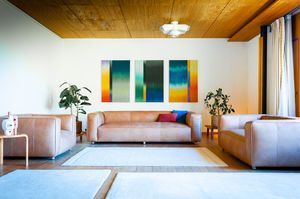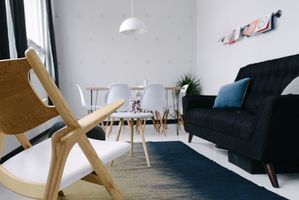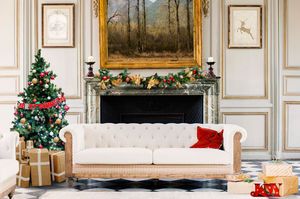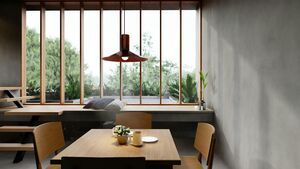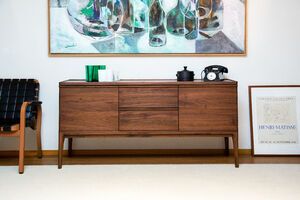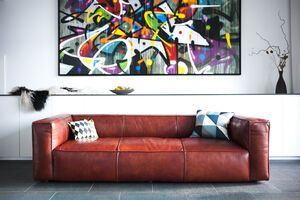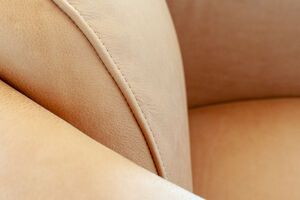Wood, a Noble Material with Many Faces
Wood holds a special place in the world of furniture. As a living, durable, and sensory material, it spans centuries without ever becoming stagnant. It patinas, develops nuances, and reacts to air, light, and touch. But not all woods are alike.
From density, grain, and color to stability, each species has its own personality. Learning to distinguish them helps you understand what you are choosing?not to judge, but to fully appreciate what each wood has to offer.
Oak, Ash, Beech: The Timeless European Woods
Among the most common woods in Europe, oak holds a special place?both heritage and contemporary. Dense and strong (around 700 kg/m³), it stands out for its excellent mechanical resistance and remarkable longevity. Its grain is pronounced, sometimes rough, with visible growth rings and often straight but lively fibers. Its color palette ranges from golden blond to light brown, sometimes with honeyed or grayish tones depending on drying and finishing.
Oak takes well to oils, waxes, and matte finishes, which reveal the wood?s texture without encasing it. It is used both as solid wood and as high-end veneer for tabletops, legs, structures, or storage. Its natural character suits rustic lines as well as sleek designs. It ages gracefully, developing a warm patina without losing strength.
Oak can be found in minimalist Scandinavian interiors as well as traditional French craftsmanship, proving its aesthetic and functional versatility.
Ash, lighter than oak, has a naturally blonde to slightly pearly tone, sometimes with golden reflections. Its grain is often straight, its markings pronounced but not aggressive, giving it a soft, almost graphic elegance. It is a moderately dense wood (around 650 kg/m³), known for its flexibility and mechanical strength?making it excellent for furniture with fine, curved, or dynamic lines.
Often used in Scandinavian or artisanal furniture, ash allows precise joinery and refined shapes, especially in seats or legs. Its stability is generally good but reacts more to humidity changes than oak, making controlled drying and a stable environment essential. It works well with light oils or matte varnishes that preserve its natural shine without hiding the finely grained texture.
Beech stands out for its fine, uniform grain and naturally light, often slightly pinkish color. It is a dense wood (around 700 kg/m³), with a consistent texture that allows clean cuts and smooth finishes. Widely found in Central Europe, it is valued for its hardness, shock resistance, and versatility in joinery and cabinetry.
Often used for legs, chairs, or internal furniture structures, beech can handle significant mechanical stress. It is suitable for demanding industrial production as well as clean, functional lines. However, it is more ?nervous? than other woods: if not properly dried or stabilized, it can react to humidity changes, especially in width (pronounced tangential shrinkage).
In finishing, it accepts both natural tones and colored patinas, revealing a silky touch once polished or oiled. Its visual simplicity makes it an excellent support for precise forms without excessive grain or contrast.

Aarne Scandinavian Oak TV Unit
Walnut, Teak, Rosewood: Character and Depth
Walnut whether European (Juglans regia) or American (Juglans nigra)?is one of the most sought-after woods for high-end furniture. It captivates with nuanced, sometimes wavy grain and subtle contrasts. Its natural palette ranges from deep chocolate brown to light grayish brown, with warm, sometimes golden, coppery, or slightly purplish highlights depending on cut and origin. These variations offer rare visual richness without ostentation.
Medium to high density (600?700 kg/m³), walnut is easy to work and machine. It accepts oil or wax finishes well, allowing its color to shine without saturation. Over time, it develops a silky, deep patina, gaining softness and character. This timeless elegance contributes to its status as a ?noble? wood.
Walnut also shaped design history: it is inseparable from 1950s?60s American modernist furniture, notably in works by George Nakashima, the Eames, and Knoll. Back then, it became the preferred wood to embody warm modernity, contrasting steel or glass. Today, it remains a favored choice for understated pieces with strong presence.
Teak (Tectona grandis) is a tropical wood from Southeast Asia, known for exceptional durability. Dense and naturally rot-resistant, it contains oleoresins that give it remarkable resistance to moisture, insects, and fungi. These properties made it a preferred material for shipbuilding, and later for high-quality indoor and outdoor furniture. Its density ranges from 600 to 750 kg/m³ depending on origin and age, with remarkable stability even in humid conditions.
Visually, teak offers a warm palette from golden to honey brown, sometimes with darker veins or coppery highlights. Its grain is tight, regular, and pleasant to touch. It works well with oiled or matte finishes, revealing natural richness without over-saturation. Untreated, it develops a silver-gray patina over time, sought in some contexts.
A large portion of teak used today comes from reclaimed wood from traditional homes or colonial houses, mainly in Indonesia. This recycled teak, aged and already stabilized, is reworked sustainably. Properly sorted and assembled, it offers not only a second life to a noble material but also unmatched aesthetic depth: signs of use, irregular tones, visible but controlled wear.
Teak also shaped Scandinavian design history, particularly in Denmark from the 1950s to 1970s. Valued for technical and aesthetic qualities, it accompanied clean lines and precise joinery, often with oiled finishes.
Rosewood is a dense, precious wood known for its spectacular grain and deeply veined dark color. It is not a single species but a group of exotic woods from the Dalbergia genus, mainly from South America, India, or Southeast Asia. Brazilian rosewood (now CITES-protected) was long considered one of the noblest woods in cabinetry, prized for its high density (up to 850 kg/m³), stability, and luxurious aesthetics.
Its pronounced grain alternates violet-brown, chocolate, and almost black tones, often with striking patterns. Its strong visual character makes it more decorative than structural. Typically used as veneer for panels, tabletops, or contrasting details, preserving resources while exploiting visual impact.
In furniture, rosewood evokes refinement and character, sometimes vintage (1960s '70s pieces) or contemporary when used sparingly. Finishes include fine varnishes and dark oils that enhance depth. Its use is now rarer due to ecological, regulatory, and economic reasons?but it retains a special aura in high-end wood.
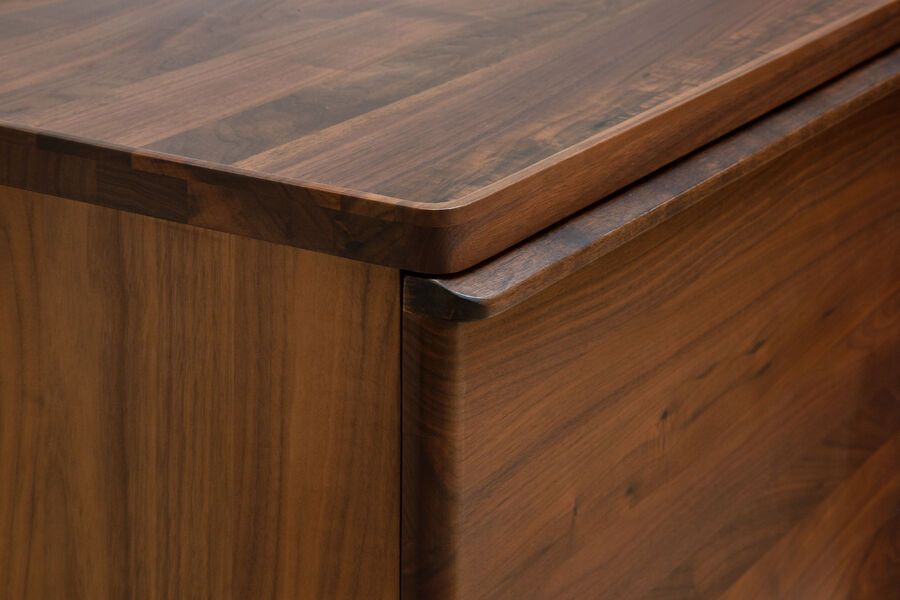
Hemët Walnut Sideboard
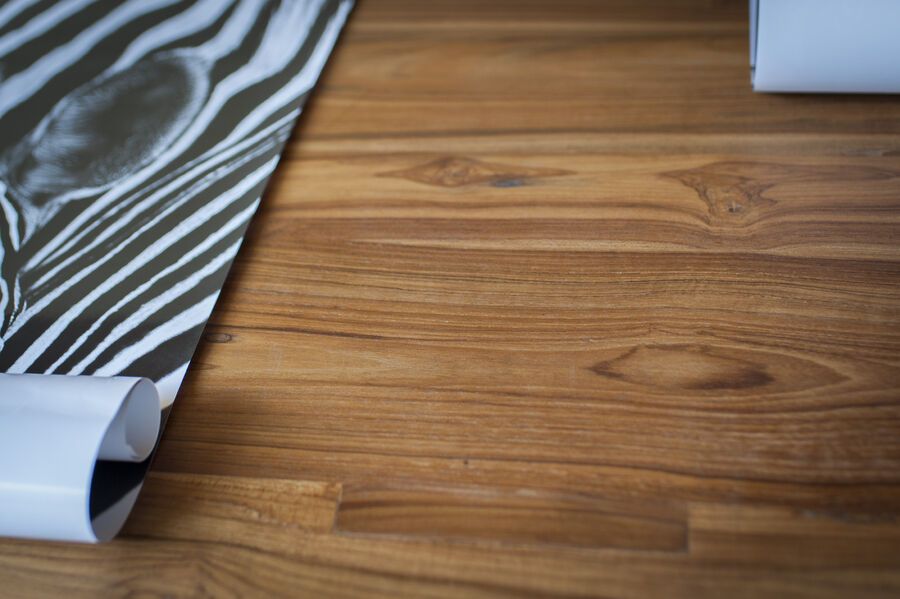
1928 Adjustable Teak Architect Table
Pine, Birch, Acacia, Mango: Simplicity and Natural Beauty
Pine is a light softwood widely found in Europe. Appreciated for its lightness, ease of machining, and affordable cost, its moderate density (around 500?550 kg/m³) makes it easy to handle, suitable for small furniture, shelves, or rustic/natural pieces. Its grain is visible, often with knots that enhance its lively, warm look.
Pine is used as both solid wood and reconstituted panels. It performs well if properly dried but is more sensitive to humidity changes and impacts than denser woods. Its touch is soft, and it takes well to oil, wax, paint, or whitewashed finishes, allowing flexible ambiance creation.
Pine evokes simple, authentic settings: holiday homes, cabins, chalets, or relaxed Scandinavian interiors. It can also be used in more contemporary compositions, especially when contrasted with raw materials (steel, concrete, dark leather).
Birch is a light wood from temperate and boreal regions, notably Northern Europe and Russia. Its grain is fine, tight, with few knots or strong contrasts. Its naturally blonde, slightly cream or ivory color gives a visually soft, almost neutral wood that delicately reflects light. It is sober and bright, highly valued in Nordic design for aesthetic and technical qualities.
Structurally, birch has medium density (around 650 kg/m³) and good dimensional stability. Used in solid wood or quality plywood?especially for modern-shaped furniture or curved panels?it has adequate mechanical strength if sections are not too thin or long, to avoid warping.
It works well with light oils, satin varnishes, or subtle lacquers, retaining its subtle grain. Its natural look fits minimalist, functional, or graphic interiors and can serve as a backdrop for more expressive materials.
Acacia is a dense, lively wood valued for natural durability and warm aesthetics. Grown mainly in Asia, East Africa, or South America, it is often a responsible alternative to more fragile or regulated exotic woods. Its density (around 750?800 kg/m³) and tannin richness make it robust, naturally resistant to moisture, insects, and daily wear?without heavy chemical treatment.
Aesthetically, acacia has lively grain with marked color variations from golden brown to deep caramel, sometimes with dark streaks. This contrast gives expressive warmth that stands out. Depending on finishing, it can be glossy or matte and textured. It accepts oils and varnishes or can be left raw for a tactile, authentic effect.
In furniture, acacia is used for robust, statement pieces: large tables, sideboards, visible structures. It has strong visual presence but retains sobriety through natural tones. Stability is good if properly dried?essential to avoid long-term stress or warping.
Mango (Mangifera indica), from India and Southeast Asia, is increasingly used in furniture, valued for ecological qualities. It comes from end-of-life fruit trees, reused instead of burned, making it a sustainable choice. Its density is medium (around 600?700 kg/m³), with good stability if properly dried and worked.
Aesthetically, mango wood is recognizable by irregular, expressive grain, with natural contrasts from light brown to dark gray, sometimes with greenish or coppery nuances. This heterogeneity gives a raw but subtle authenticity. It works well with matte or lightly brushed finishes that highlight its living texture.
Used mainly for solid or rustic furniture?sideboards, tables, storage?mango is appreciated for daily durability and visual presence.

Tongeren Solid Mango Table
Which Wood for Which Use?
Choosing a species depends on visual aspect, density, workability, and finishing response. Oak works well for structural furniture (tables, cabinets), as does beech. Ash and walnut suit finer shapes like chairs or decorative elements. Teak and acacia are chosen for resistance, especially in controlled humidity contexts.
As for finishing, species respond differently. Oak takes oils and waxes well, highlighting the grain. Walnut requires subtle products to avoid masking its shades. Softer woods like pine need protective treatment to avoid visible marks.
There is no strict hierarchy among species. Quality depends on craftsmanship, origin, and care in processing.
At PIB, the Importance of Material Choice
At PIB, we select each species for what it expresses accurately. Solid wood is favored when relevant, for presence, aging capacity, and density. Veneer can also be used?not to hide, but to allow finer, more stable constructions without warping.
What matters is the relationship with the material: sincere, balanced, designed to last. Each piece should tell a story of the right relationship between form, use, and the wood composing it.

